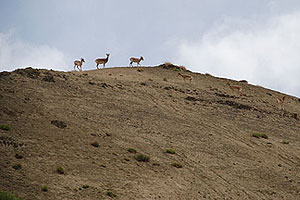|
Ladakh,
also known as the 'land of passes', was discovered by
Fa-hian, who traveled across its inhospitable terrain in
399 AD. He described Ladakh as the land where snow never
melts and only corn ripens. For endless years, before
man had even discovered this remote land, several
animals and birds lived together here in an exquisite
equilibrium. Today, Ladakh's flora and fauna are
threatened and protection is vital if the ancient
ecosystem has to survive the trauma |
 |
|
|
of modern
man. The area of Ladakh is unique and its climate supports
some rare species of animals and birds. In this extremely
harsh environment, animals, which have adapted to the rigorous
conditions however, thrive on the minimal vegetation, poor
shelter, rocky terrain and bitter cold. Most of the creatures
migrate to lower regions in winter while others, like the
brown bear and marmots hibernate. Ironically, at this altitude
many animals suffer from "mountain sickness" because of the
lack of oxygen! Most of the large mammals have a unique device
for protection against the cold - a highly insulated shaggy
coat. They, therefore, have less need for shelter from the
elements. Due to this, more species of goat and sheep live
here in open country than anywhere else on earth.
Birds
The Black necked cranes, Bactrian magpies, Turkoman rock
pigeon, desert wheaters, buntings, larks, kite, kestrel and
many kinds of finches, ducks, geese and hundreds of species of
rare Himalayan birds inhabits the region of Ladakh. Many
migratory birds can be seen in Ladakh during the summer month.
The most famous of them is the Black-necked Crane, which can
be seen in V-shaped formation across the clear Himalayan sky.
Ibex
Ibex can be seen on the high steep cliffs of Ladakh. Ibex is
an impressive goats with huge curved horns.
Bharal
Bharal, a blue sheep can be seen at the height of 6000 feet.
In summers they graze on the rich and abundant grasses of the
alpine meadows. Their brownish-gray color provides them with
protective camouflage and as they often stand motionless they
can be extremely difficult to spot but, when alarmed, Bharal
will bolt swiftly to safety. As this species of sheep possess
the appearance of both sheep and goat, so they play a vital
role in the mythological stories related to Buddhism. |
|
Nyan
Nyan, the great Tibetan Sheep is another attraction of Ladakh.
Nyan is the largest and most magnificent wild sheep. About 200
Nyans are found in the extreme eastern portion of Ladakh. The
Nyan normally remains at a great height and rarely descends to
a level below 4,500 meters. Male Nyans are very attractive as
they have long and huge curving horns which measures as long
as up to 140 cms. The fighting between two Nyan makes it a
good photo motive.
Urial
Small sheep, also known as Urial or Shapu can be seen at a
height of 3000 to 4000 meter in the grassy mountain slopes.
Urial also play an important role in the local food chain of
the hunting animals. The Urial weighs 85 Kg. and has horns
measuring upto 99 cm. Urial is the smallest sheep in eastern
Asia. The meeting of these species takes place during
December-January and they give birth to their young ones
around May. The need for protection of the Urial is great as
they are within the easy reach of hunters. Their numbers have
been declining rapidly and it is estimated that there are not
more than 500 sheep in Ladakh. According to the survey by the
Wildlife Department of Jammu & Kashmir there are only 34 to 50
sheep in the Markha and Rumbak valleys. |
|
which is
tinged with gray at the muzzle. The yaks graze on the
Himalayan valley at the height of over 6,000 meters in summer.
In the winters, yaks migrate to lakes, marshes and lower
valleys.
Tibetan Gazelle
The Tibetan gazelle is one of the rarest animal. The Tibetan
gazelle or the Tibetan antelope is prized for its fleece which
produces Shahtoosh, the very best wool.
Chiru
A rare Tibetan gazelle or the Tibetan antelope “Chiru” can be
seen in small groups. “Chiru” falls under the protected
species. This antelope is prized for its fleece which produces
Shahtoosh, the very fine best wool used to make shawls. Now
the trading of the wool has been banned in order to ensure the
survival of these wonderful antelopes. |